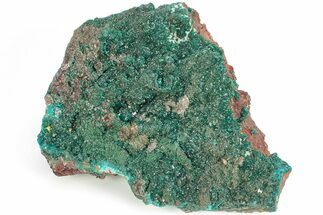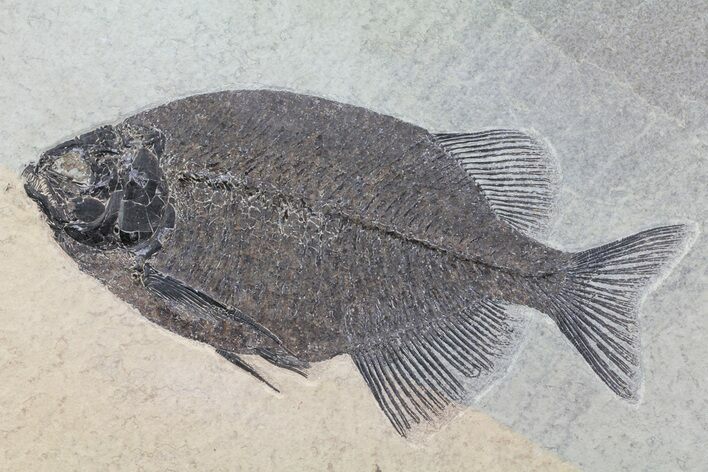This Specimen has been sold.
9.1" Fossil Fish (Phareodus) From Wyoming - Excellent Specimen
This is a very nice, 9.3" long example of one of the more uncommon fossil fish found in the Green River Formation, Phareodus testis. The fish has a natural, dark brown preservation and is nicely centered on a multi-toned, solid slab of shale. Just check out the detail on the fish including all of it's fins and teeth. The rock is just slightly curved.
Comes with a display stand. We can add a backing and wall hanger upon request for an additional $20.
If you look closely you can see how Phareodus has a mouthful of sharp pointy teeth making is a voracious lake predator. In fact the name Phareodus actually means "to have tooth" Spines from other fish such as Mioplosus and Priscacara have frequently been found preserved in it's stomach.
Comes with a display stand. We can add a backing and wall hanger upon request for an additional $20.
If you look closely you can see how Phareodus has a mouthful of sharp pointy teeth making is a voracious lake predator. In fact the name Phareodus actually means "to have tooth" Spines from other fish such as Mioplosus and Priscacara have frequently been found preserved in it's stomach.
About Fossil Lake
50 million years ago, in the Eocene epoch, these fish thrived in Fossil Lake, which was fed by the Uinta and Rocky Mountain highlands. The anoxic conditions at the bottom of Fossil Lake slowed bacterial decomposition, prevented scavengers from disturbing corpses, and, most interestingly, suffocated creatures that ventured into the oxygen-starved aquatic layer. The result is a miraculous exhibition of Eocene biota: a subtropical aquatic community within sycamore forests, teeming with creatures such as freshwater stingrays, dog-sized horses, menacing alligators, early flying bats, and one of the first primates.
50 million years ago, in the Eocene epoch, these fish thrived in Fossil Lake, which was fed by the Uinta and Rocky Mountain highlands. The anoxic conditions at the bottom of Fossil Lake slowed bacterial decomposition, prevented scavengers from disturbing corpses, and, most interestingly, suffocated creatures that ventured into the oxygen-starved aquatic layer. The result is a miraculous exhibition of Eocene biota: a subtropical aquatic community within sycamore forests, teeming with creatures such as freshwater stingrays, dog-sized horses, menacing alligators, early flying bats, and one of the first primates.
SPECIES
Phareodus testis
LOCATION
Kemmerer, Wyoming
FORMATION
Green River Formation
SIZE
9.1" long on 12x8.3" rock
CATEGORY
SUB CATEGORY
ITEM
#78627
We guarantee the authenticity of all of our specimens.
 Reviews
Reviews













